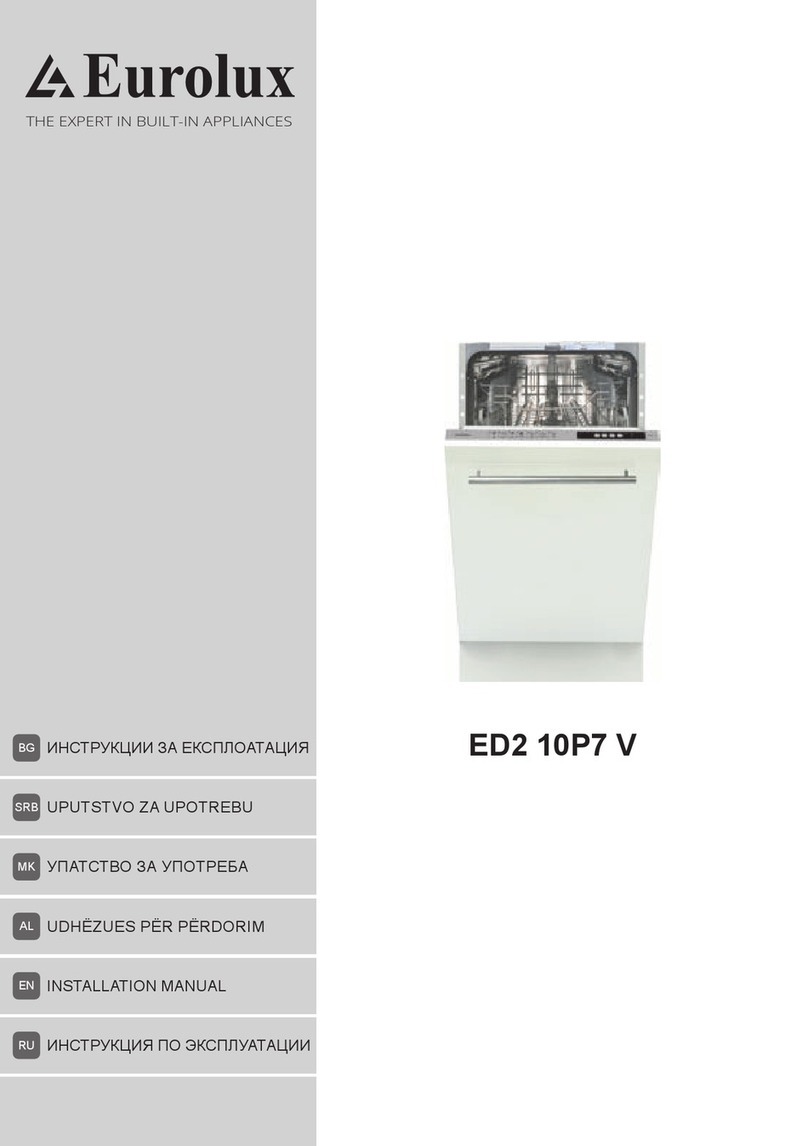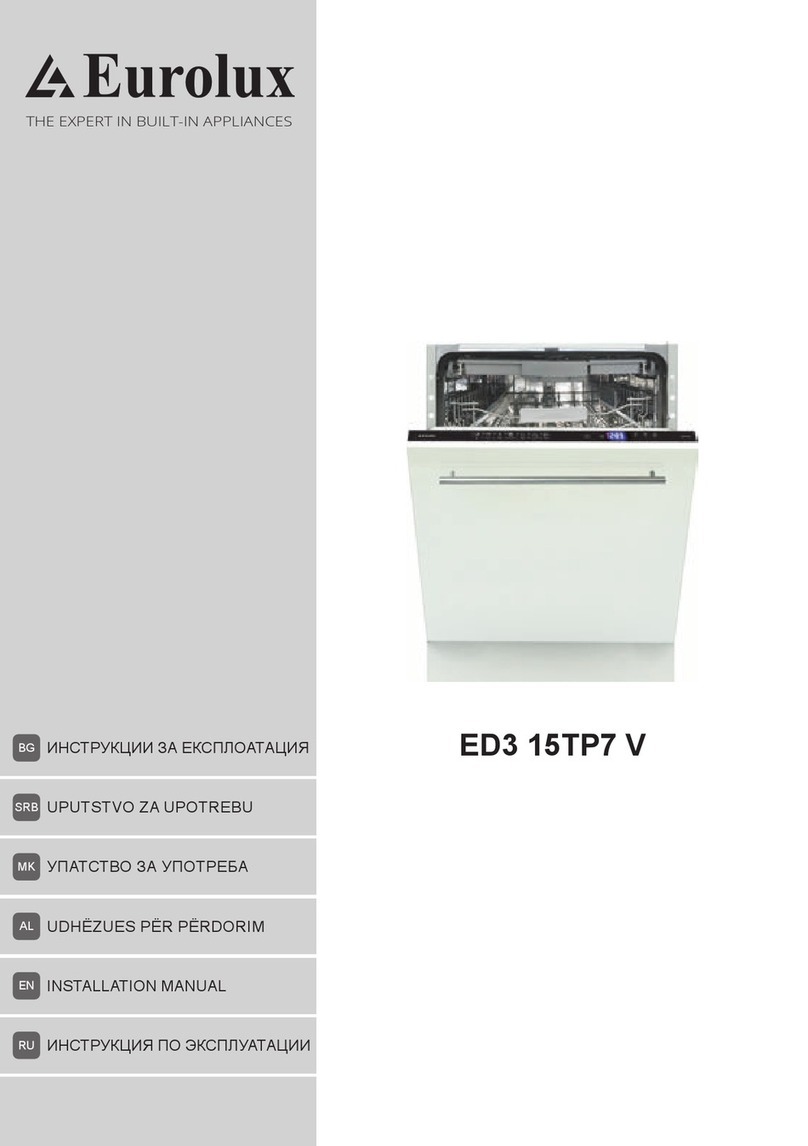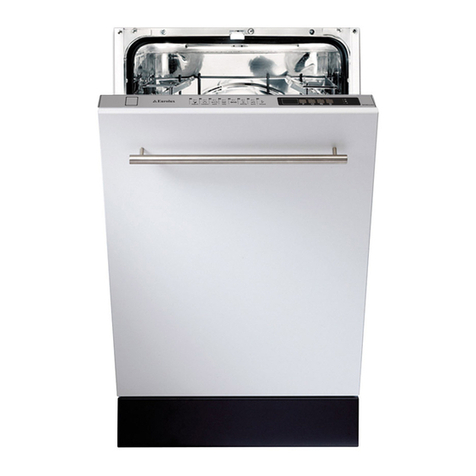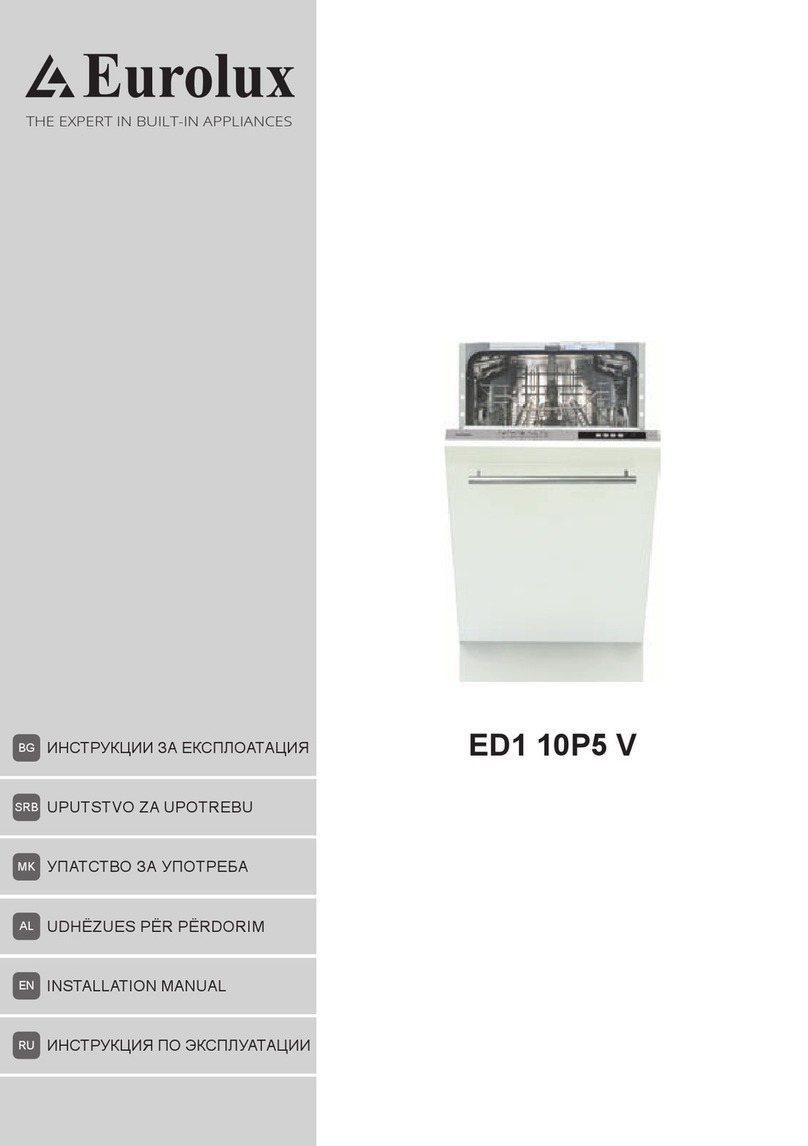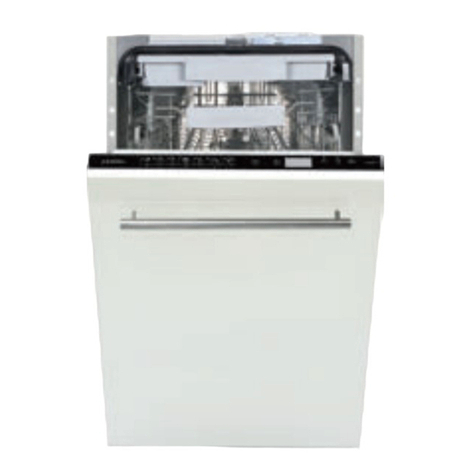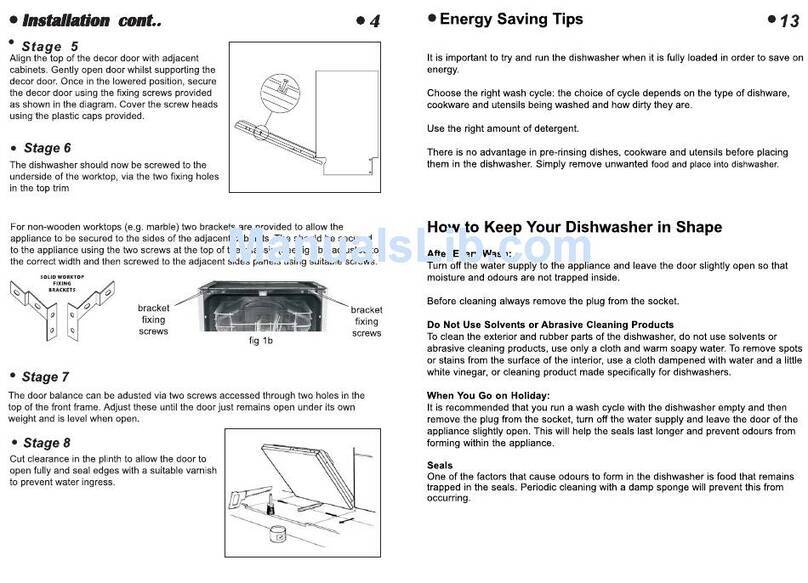Eurolux DW12-CBE7 User manual

Code: 012050
Dishwasher
DW12-CBE7
Instructions for Use

1
Index
en
Safety information
Installation
Getting to know your dishwasher
How to fill the salt
How to fill rinse aid
How to fill the detergent
Not suitable for the dishwasher
Arranging crockery, glasses, etc. in the dishwasher
Programme overview
Washing dishes
How to keep your dishwasher in shape
Care and maintenance
Fault finding
Technical data
Important information
2
4
11
12
13
13
14
15
17
19
24
25
26
30
30

2
Safety information
en
The dishwasher must only be used by adults for the washing of household dishes and cooking utensils.
This appliance cannot be installed outdoor, not even if the area in which it is installed is covered by a
roof; it is also very dangerous to leave it exposed to the rain and elements.
Do not place any heavy objects or stand on the door when it is open. The appliance could tip forward.
The water inside the dishwasher is not suitable for drinking.
Do not use solvents of any kind inside your dishwasher. They could cause an explosion danger.
Open the door very carefully if the dishwasher is operating. There is a risk of water squirting out.
During normal use
Do not touch the heating element during or after a wash cycle.
Fundamental rules to follow when using the appliance:
- Never touch the dishwasher when barefoot or with wet hands or feet;
- We discourage the use of extension cords and multiple sockets;
- If the appliance is not operating properly or maintenance must be performed, disconnect the
appliance from the power supply.
Place the dishwasher and connect it up in accordance with the installation instructions.
The dishwasher must not be connected to the electricity supply while installation is being carried out.
Ensure that the domestic wiring is properly earthed.
The mains electricity supply must conform to the details shown on the dishwasher nameplate.
Do not connect the dishwasher to the electricity supply via an extension cable.
Built-under and built-in appliances should always be installed under a continuous work surface which
is attached to the adjacent cupboards, in order to ensure that the appliance is entirely stable.
After the appliance has been installed,the mains plug should still be easily accessible.
The plastic housing on the water inlet contains an electrically operated valve.The connecting wires
are inside the inlethose.Do not cut through this hose and do not immerse the plastic housing in water.
During installation, the power supply cord must not be excessively or dangerously bent or flattened.
During installation
For Switzerland only:
There are no restrictions on installing the appliance between wooden or plastic walls as part of a fitted
kitchen. If the appliance is not plugged into a wall socket, it must be connected to the mains via a
separator for all poles within the domestic wiring system. This device must have a gap of at least 3mm
between open contacts, in order to conform with relevant safety regulations.
At time of delivery
Check packaging and dishwasher immediately for signs of transport damage. If the appliance is
damaged, do not put it into use but contact your supplier or customer service without delay.
Please dispose of packaging materials properly.

3
If your family includes children
This appliance is not intended for use by persons (including children) with reduced physical,sensory
or mental capcabilities, or lack of experience and knowledge,unless they have been given supervi-
sion or instruction concerning use of the appliance by a person responsible for their safety.
Children should be supervised to ensure that they to not play with the appliance.
Keep detergents out of the reach of children, who must also be kept away from the dishwasher when
it is open.
If a fault occurs
If the appliance malfunctions, turn off water supply to the appliance and disconnect the plug from the
wall socket. Then, consult the section entitled, "Fault finding" .If you cannot solve the problem, con-
tact a service center.
Only specialised personnel are authorised to make repairs.
If the supply cord is damaged ,it must be replaced by the manufacture ,its service agent of similarly
qualified persons in order to avoid a hazard.
To maintain the EFFICIENCY and SAFETY of this appliance,we recommend:
- call only the Service Centers authorized by the manufacturer.
- always use original Spare Parts.
When disposing of old appliances
Appliances which are no longer being used must be made inoperable by cutting the power supply
cord and removing the door lock.
Take the appliance to a designated waste disposal center.
Dangerous voltage
en
Warning
Children could get locked in the appliance (risk of suffocation)
or get stuck in other positions. Therefore: Remove the mains
plug, cut the mains wire and set aside. Damage the door lock so
that the door can no longer be closed.

4
Cold water connection
Some models are fitted with an "Aquastop" water supply hose
(see fig.A) in which the small filter is already housed in the
threaded end.
If the water pipes are new or have not been used for an ex-
tended period of time, let the water run to make sure that the
water is clear and free of impurities. If this precaution is not
taken, there is a risk that the water inlet can get blocked and
damage the appliance.
Positioning the appliance
Change the appliance in the desired location. The back should rest against the wall behind it, and the
sides, along the adjacent cabinets or wall. The dishwasher is equipped with water supply and drain
hoses that can be positioned to the right or the left to facilitate proper installation.
fig.A
Anti-Flooding protection
If dishwasher is equipped with a system that stops the supply of water in the event of a problem with the water
supply hose, or leaks within the unit, in order to prevent damage to your home. If for any reason the box contain-
ing the electrical components happens to get damaged, remove the plug for the appliance from the socket
immediately. In order to guarantee that the anti-flooding feature operates properly, the "A" box with water supply
hose must be attached to the water supply tap as shown in fig.A. No other type of connection is acceptable.The
water supply hose must not, under any circumstances, be cut, as it contains electrical parts which are live. If the
length of the hose is not adequate to make a proper connection, the hose must be replaced with one which is
long enough. This hose is available upon request from specialised retailers and service center.
Levelling the appliance
Once the appliance is positioned,adjust the feet (screwing them
in or out) to adjust the dishwasher, making it level. In any case,
the appliance should not be inclined more than 2˚. If the appli-
ance is levelled, it will help ensure proper performance.
Installation
en
Warning
The appliance is to be connected to the water mains using new hose-
sets and that old hose-sets should not be reused.

5
Drain hose connection
Insert the drain hose into a drain pipe with a minimum diameter of 4cm, or let it run into the sink, making
sure to avoid bending or crimping it. If necessary, fit a syphon trap (U-bend) with a connecting piece for
the drain hose (fig.B). The free end of the hose must be at a height between 40 and 100 cm and must not
be immersed in water.
fig.B
Attention:
The connecting piece for syphon trap (U-bend) must be solidly
fastened to the wall to prevent the drain hose from moving and
allowing water to spill outside the drain.
Electrical Connection
After making sure that the voltage and frequency values for the current in the home correspond to those
on the rating plate (located on the stainless steel inner door of the appliance) and that the electrical
system is correct for the maximum voltage on the rating plate, insert the plug into an electrical socket
which is earthed properly (the earthing of the appliance is a safety requirement mandated by law).
If the electrical socket to which the appliance must be connected is not appropriate for the plug, replace
the whole cable, rather than using adaptors or the similar like as they could cause overheating and
burns.
Caution:
The dishwasher plug must be accessible even when the appli-
ance is installed as a built-in unit so that maintenance can be
done safely.
en

Supplied with the appliance is a plastic (self adhesive)
anticondensation strip, this should be fixed to the underside of
your worktop along the front edge. The adjustable feet of the ap-
pliance allow it to be raised up to 870mm, if the space between
the floor and the underside of the work surface is greater than
870mm, then the appliance should be positioned on suitable
Stage 1
Installation cont..
fig 1a
wooden spacers which should always befixed to the floor. Always use a spirit level to make sure that the
appliance is level left to right and front to back.(If the appliance is installed on a carpet, ensure there is
clearance beneath the appliance). The four adjustable feet should be adjusted to the correct height; the
rear feet are adjustable via studs at the front of the appliance (fig 1a).
To preventdamage to the floor covering, the appliance must be installed using the plastic skids provided.
Stage 2
Connect the water, drain and electrical supplies (220V~240V, 50Hz). We recommend that the appliance
is connected to a cold water supply.
Measure the width of the decor door.Align the template on the rear of the door with the top of the door
level with the top of the template, and the left hand edge of the door in line with the measured door width.
Mark the four fixing poisitions. Repeat on the right hand side. Remove the template, and drill pilot holes
in the door in all eight positions using a suitable drill (take care not to drill through the door). Attach the
upper plastic studs and lower fixing brackets to the decor door as shown below.
Stage 3
Position the decor door onto the front of the dishwasher by locat-
ing the brackets into the two plasticstuds mounted either side on
the top of the door. Lift the decor door until the lower brackets
locate into the slots in the appliance door.
Stage 4
6
en

Align the top of the decor door with adjacent cabinets. Gently
open door whilst supporting the decor door. Once in the lowered
position, secure the decor door using the fixing screws provided
as shown in the diagram. Cover the screw heads using the plas-
tic caps provided.
Stage 5
The dishwasher should now be screwed to the underside of the worktop, via the two fixing holes in the
top trim.
For non-wooden worktops (e.g. marble) two brackets are provided to allow the appliance to be secured
to the sides of the adjacent cabinets. The should be secured to the appliance using the two screws at the
top of the chassis (see fig 1b), adjusted to the correct width and then screwed to the adjacent sides
panels using suitable screws.
Stage 6
The door balance can be adusted via two screws accessed through two holes in the top of the front
frame. Adjust these until the door just remains open under its own weight and is level when open.
Stage 7
Cut clearance in the plinth to allow the door to open fully and seal
edges with a suitable varnish to prevent water ingress.
Stage 8
7
en

Assembly Instructions for Integrated Dishwasher
Mounting the Wooden Panel onto the Door and
Sliding the Dishwasher into the Cabinet
During the preparatory stages for installing the dishwasher into
the kitchen cabinet, holes must not be drilled in the sides, or door,
in order to avoid compromising the performance and/or operation
of the appliance. Before working on any internal components, the
unit must be disconnected from the power supply .The maximum
dimensions for the wood panel that can be installed on the door
are: Height - 725 mm; Width - 598 mm; Thickness:20 mm.
Align the top edge of the template (identified with the “A” arrow ) with
the top edge of the panel. On both sides of the template (top and
bottom ) are written the various dimensions that correspond to the
different possible widths for the panel. Align the template with the
side of the panel (left or right), making sure that the panel coincides
with the appropriate dimensions. Mark the positions for the holes for
the screws, using the tip of a drill or a pencil. The three holes closest
to the side should be used(B). Repeat this step on the other side of
the panel ,using the corresponding side of the template.
Using the Drilling Template (see Fig.1)
AB
Fig.1
8
en
At the point marked, drill holes 2 mm in diameter. If the panel is
made of chip board, only drill through the veneer. If the panel is
made of solid wood, the holes can be made deeper. Position the
two brackets so that they are lined up with the holes made in the
bottom part of the panel. The holes furthest to the outside should
be used to fasten the brackets. The small fins should be turned
downward. The hooks in the totally built-in version should be
screwed into the two holes at the top.
Fastening the Bracket to the Wooden Panel (see Fig.2)
Place the wood panel onto the door of the dishwasher. Then per-
form the installation steps described below.
Mounting the Wood Door Panel onto the Dishwasher
Fig.2

9
en
Insert the top hooks into the appropriate slots in the dishwasher
control panel. Then push the panel upwards until it stops. After-
wards , slide the panel downward again, moving the bottom of the
panel toward the door so that the fins on the brackets slide into
their slots (see Fig.3).
Open the doors of the dishwasher (the panel should stay in place
by itself) and align the panel with the door, keeping it in contact
with the control panel. Remove the small plastic plugs that cover
the holes on the inside of the dishwasher door and fasten the panel
in place with the screws provided (see Fig.4). Remember to cover
the two holes with the plastic plugs removed earlier.
Installation of Continuous Base Moulding
Position the washing machine in the cut-out in the kitchen cabinet:
1.
Install the continuous base moulding, following the manufacturer’s
instructions.
2. Slowly open the door of the dishwasher to check to see if the
door strikes or rubs against the base moulding.
3. If so, rest the bottom edge of the panel on the base moulding
and mark the part to be cut. Leave at least 3 mm of the play
between the panel and the base moulding to allow for the door to
rotate freely (see Fig.6).
4.
Remove the base moulding and trim it as needed, protecting the sur-
face that has been cut with a paint or similar wood finish (see Fig.6).
5. Install the base moulding again (see Fig.7).
Fig.4
2-7Kg
Fig.3
A
B
2Kg
7Kg
Fig.5
Fig.6
Fig.7
The door must be perfectly balanced. In the factory , the tension
of the springs is regulated to ensure that the door is perfectly
balanced when light wood door panels are mounted on the door.
If heavier, solid wood door panels are used, the door can be bal-
anced by simply turning the two screws (both screws must be
turned the same amount) located on the top part of the machine.
Adjusting the Door Springs (see Fig.5B)
Adjustment of Back Feet (see Fig.5A)
Insert the appliance in the cutout and then adjust the height of the
machine using the screws located at the bottom front .Use a screw-
driver to turn the screws in a clockwise direction to raise the dish-
washer and in an anticlockwise direction lower it.

Positioning the Unit within the Cutout (see Fig.9)
Push the dishwasher into the cutout opening and turn the feet to
make it level and to adjust for height so that the crosspiece (A) for
fastening it in place located on the top part of the machine (see
Fig.9) comes into contact with the counter .Align the door panel
mounted on the dishwasher with the doors on the adjacent cabinet (2).
Important:
The dishwasher must absolutely be fastened to the counter top to
prevent the machine from tipping when the loaded dish racks are
pulled out.
How to use water-proof plastic
Firstly take off the water-proof plastic from the sticker with the ap-
pliance (see I, Fig.8). Secondly stick it on the bottom of the kitchen
board (see II, Fig.8). All of this can avoid humidity in the kitchen.
NOTICE:
If power screwdrivers are used to make the adjustment, make the final adjustment manu-
ally with a normal screwdriver.
Fig.8
Fig.9
10
en

Getting to know your dishwasher
Close-up view (control panel)
11
Dishwasher interior
en
A
C
B
EGI
DHFJ
Low Salt Indicator
A
B
C
D
E
Low Rinse Aid Indicator
Programme Indicator
Programme Button
"3 in 1" Button
F
G
H
I
JON-OFF Button
" 1/2 " Button
Delayed Start Button
ON-OFF Indicator
Time-remaining Indicator
Upper Rack
a
b
c
d
e
f
Top Spray Arm
Silverware Basket
Third Sprayer
Bottom Spray Arm
Lower Rack
Detergent and Rinse Aid Dispenser
g
h
i
j
k
l
Salt Container Cap
Washing Filter
Water Inlet Hose(with “Aquastop”)
Drain Hose
Power Supply Cord
a
e
df
g
h
i
j
k
l
b
c

Salt
The hardness of the water varies from place to place. If hard water is used in the dishwasher, deposits
will form on the dishes and utensils.
The appliance is equipped with a special softener that uses a salt specifically designed to eliminate lime
and minerals from the water.
How to fill the salt
Loading the salt into the container
Always use salt intended for use with dishwashers.
The salt container is located beneath the lower rack and should
be filled as follows:
12
When the low salt indicator “E” lights, you must fill the salt.
Remove the lower rack and then unscrew and remove
the cap from the salt container;
If you are filling the container for the first time, fill it with water;
Place the end of the funnel (supplied) into the hole and introduce about 2 kg of salt. It is normal for
a small amount of water to come out of the salt container.
Carefully screw the cap back on.
Important
To prevent the formation of rust, load the salt just before beginning a
wash cycle.
en
E
Adjusting salt consumption
The dishwasher is designed to allow for adjusting the amount of salt consumed based on the hardness
of the water used. This is intended to optimize and customize the level of salt consumption so that it
remains at a minimum.
To adjust salt consumption, proceed as follows:
It is recommended that adjustments be made in accordance with the following table:
Water Hardness
Clarke
degrees ºdH mmol/l Selector
position
Salt
consumption
(Grams/cycle)
Autonomy
(cycles/2kg)
0 - 14 0 - 17 0 - 1,7
1,8 - 4,418 - 4414 - 36
36 - 71 45 - 89 4,5 - 8,9
>89>71 >8,9
/
"-"
middle
/0
20
40
60"+"
60
40
25
Level
1
2
3
4
Unscrew the cap from the salt container;
There is a ring on the container with an arrow on it (see
figure to the side),
If necessary, rotate the ring in an anticlockwise direction
from the "-" setting towards the "+" sign, based on the
hardness of the water being used.

Rinse aid
This product makes dishes sparkle and helps them to dry without spotting. The dispenser is located on the inside
panel of the door .
Loading the rinse aid
Regardless of the type of detergent dispenser installed on your
appliance, you must proceed as indicated below when loading the rinse
aid.
To open the dispenser, turn the "1" cap in an anti-clockwise direction
and then pour in the rinse aid, making sure not to overfill. The amount
of rinse aid used for each cycle can be regulated by turning the "2"
dose adjuster, located beneath the "1" cap, with a screwdriver.
There are 6 different settings; the normal dosage setting is 3.
How to fill rinse aid
When the low rinse aid indicator “ D” lights , you must load rinse aid .
en
D
12
How to fill the detergent
Detergent
Detergent specifically intended for use with dishwashers must be used. The
dispenser must be refilled before the start of each wash cycle following the
instructions provided in the "Programme overview". The detergent dispenser is
located on the inside panel of the door.
Loading the detergent
4
3
To open the " 3 "cover on the dispenser, press the " 4 "button.
The detergent for the wash cycle should bepouredintothe " 5 " compartment.
The detergent for the pre-wash cycle should be poured into the “ 6 ”
compartment.
After the detergent has been placed in the dispenser, close the cover and
press down until it clicks in place.
5
6
Notice:
The usage of 3 in 1 or similar tablets is forbidden when Heat wash, Rapid Wash and Soak
programmes are selected.
Notice:
To facilitate closing the cover, remove any excess of detergent on the edges of the dispenser.
Important
Proper dosage of the rinse aid improves drying. If drops of water remain on the dishes or spot-
ting occurs, the dosage adjuster should be turned to a higher setting. If the dishes have white
streaks, turn the dosage adjuster to a lower setting.
13

14
en
Not suitable for the dishwasher
What you should not put into the dishwasher
Cutlery and tableware manufactured in whole or part from wood.They become faded and unsightly in
appearance.Furthermore,the adhesives that are used are not suitable for the temperature that occur
inside the dishwasher.Delicate decorative glassware and vases,special antique or irreplaceable china.
The decorative patterns on such items will not be dishwasher-proof.
Plastic objects that are not resistant to hot water, copper and pewter utensils are also not suitable.
Decorative patterns printed or painted onto the surface of crockery, glasses, etc.,aluminium and silver
items tend to become discoloured or faded if washed in the diswasher. Some types of glass can become
opaque in appearance after they have been washed many times in a dishwasher. Highly absorbent
materials, such as sponges and towels,should never be placed in the dishwasher.
Our recommendation
In future, only purchase table or kitchenware that has been confirmed as being dishwasher-proof.
Important
Dishes or cutlery that have been soiled by tobacco ash, wax,
Iubricating grease or paint, should not be put in the dishwasher.
Damage to glassware and other dishes
Possible causes
type of glass or manufacturing process
chemical composition of detergent
water temperature and duration of dishwasher programme.
Use glassware or porcelain dishes that have been marked ‘dishwasher-proof’ by the manufacturer.
Use a mild detergent that is described as ‘kind to dishes’. If necessary, seek further information from
detergent manufacturers.
Select a programme with a low temperature and a short duration as possible.
To prevent damage, take glass and cutlery out of the dishwasher as soon as possible after the
programme has ended.
Suggested remedy

15
en
Arranging crockery, glasses, etc. in the dishwasher
Using the lower rack
Before placing the dishes in the dishwasher,re-
move larger food particles to prevent the filter from
becoming clogged, resulting in reduced
performance.
If the pots and pans have baked-on food that is
extremely hard to remove,we recommend that they
are soaked before washed.This will eliminate the
need for extra wash cycles.
Pull out the rack to load the dishwasher.
We recommend that you place the most difficult to
clean items on the lower rack:pots,pans,lids,serv-
ing dishes and bowls (Fig.D).
It is preferable to place serving dishes and lids on
the sides of the racks to avoid blocking the rota-
tion of the top spray arm.
Pots,serving bowls,etc.must always be placed face
down.
Deep pots should be slanted to allow the water to
flow out.
The cutlery basket can be doubled (Fig.E)so that
only one section may be used when the cutlery
load is light.This also makes space for additional
pots and pans and it can also be placed in the
upper rack.
Warning
Knives and other utensils with sharp
points must be loaded in the basket
with their points down or placed in a
horizontal position.
fig.D
fig.E
E1 E2
E5
E3 E4

16
en
Knife rack
The knife rack clips onto the side of the top basket,giving you
the freedom to wash your large sharp knives separately and
out of harm ’s way (Fig.H).
The lower rack features fold down tine rows (see fig.I) so
that larger or more pots and pans can be loaded.
Shelf
Lean tall glasses and those with long stems against the shelf.
DO NOT lean them against other items to be washed.
Place glasses,cups and small bowls on the additional cup rack.
The additional cup rack can be swivelled in or out as required
(Fig.G).
ArtNo.800-0304 - Using the cup rack
ArtNo.800-0305 - Knife rack
fig.H
fig.G
I1
I2
I3
fig.I
Using the upper rack
The upper rack is designed to hold more delicate and lighter
dishware,such as glasses,cups and saucers,plates,small
bowls and shallow pans (as long as they are not too dirty).
Position the dishes and cookware so that the spray of water
does not move them.
The upper rack can be adjusted for height (Fig.F).Undo the
retaining clips on the telescopic runners (F1).Slide the rack
out (F2),refit on the lower wheels and push back along the
runners (F3).Close the retaining clips (F4).
Adjust the upper basket to the higher level and you have more
space to accommodate taller pans and trays in the bottom
basket.
fig.F
F1 F4
F3
F2

Programme overview
Wash
programme
Type of
crokery e.g.
china, pots/
pan s,
cutiery,
glasses, etc
Amount of
food
remains Description of cycle
Condi-
tion of
food
remains
1/2
Load
Pre-wash with hot water.
Extended wash at 70°C.
Rinses with cold water.
Rinse with hot water.
Drying.
Pre-wash use cold water.
Extended wash at 55°C.
Rinse with cold water.
Rinse with hot water.
Drying.
Short wash at 40°C.
Cold rinse.
Short cold wash to pre-
vent food residue from
drying on the dishes .
Pre-wash use cold water.
Extended wash at 50°C.
Rinse with cold water.
Rinse with hot water.
Drying.
Wash at 45°C.
Rinse with cold water.
Hot rinse.
Drying.
Soups,
casseroles,
sauces,
potatoes,
pasts, rice,
eggs, roast or
fried food.
a lot
a little
stuck
on hard
Soups,
potatoes,
pasta, rice,
eggs, roast or
fried food.
loosely
attached
Coffee,cakes,
milk, sausage,
cold drinks,
salads
Very little loosely
attached
Rinse off if the dishes have been
stacked for several days in the dish-
washer prior to washing.
Type of
food
remains
Non-
delicate
Mixed
Intensive
Wash
Normal
Wash
Light Wash
(EN50242)
Glass ware
Soak
Rapid wash
17
en
Heat wash
Hot rinse at 65°C.
Drying.
For dishes that need to be rinsed
and dried only.
3 in 1

Delayed
Start
Detergent Rinse Aid Duration in
minutes
Energy
consump-
tion in kWh
Water
consump-
tion in litres
112
94
102
90
162
140
92
82
32
28
54
48
12
12
1.44
1.25
1.11
1.00
1.05
0.95
1.01
0.95
0.40
0.30
0.90
0.78
0.02
0.02
18
16
15
14
15
13
12
10
9
8
5.5
5
3
3
18
en
*EN50242 test with rinse aid setting 5
Prewash
5g
5g
5g
5g
5g
5g
Extended
Wash
25g
25g
25g
25g
25g
25g
15g
10g
15g
10g

Washing dishes
Programme selection
The most appropriate programme can be identified by comparing the type of crockery, cutlery, etc., as
well as the amount and condition of food remains, with the details contained in the wash cycle table.The
corresponding programme sequence, duration and consumption details are shown in the right half of the
overview.
For example:
Use the« normal» programme for dishes and utensils which have plenty of food remains stuck on
hard.
Earn savings
If only a small number of dishes have been loaded into the dishwasher,selecting a programme that
operates at the next lowest temperature will usually be sufficient.
Programme data
The stated programme data are based on standard operating conditions. The values can vary consider-
ably according to:
different amounts of dishes
temperature of mains water supply
pressure of mains water supply
ambient temperature
fluctuations in mains voltage
machine-related factors (e.g. temperature, water volume,...)
19
en
Table of contents
Other Eurolux Dishwasher manuals

Eurolux
Eurolux DW12V-AAA-9 User manual

Eurolux
Eurolux DW12VE - A++AA-6 User manual
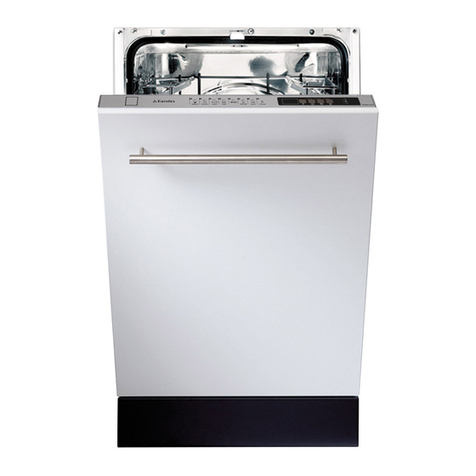
Eurolux
Eurolux DW10VEE-A++AA-8 User manual
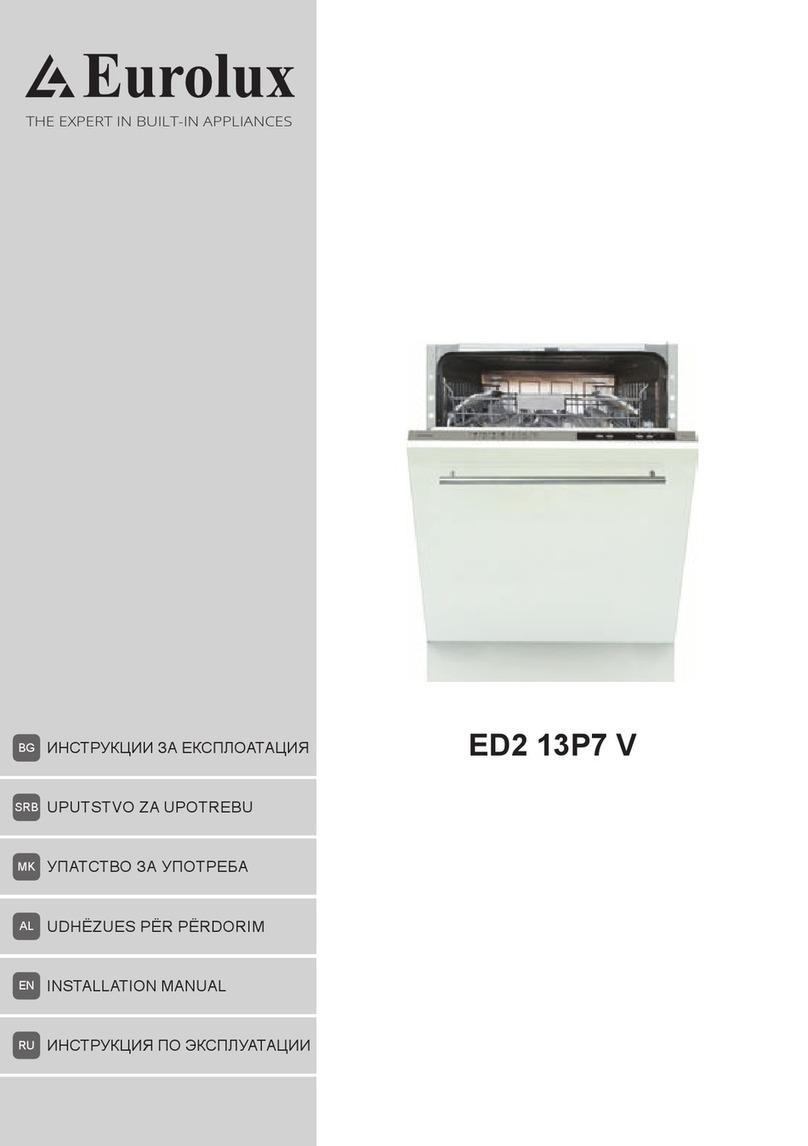
Eurolux
Eurolux ED2 13P7 V User manual

Eurolux
Eurolux EDW612X Guide

Eurolux
Eurolux ED4 10TP9 V User manual
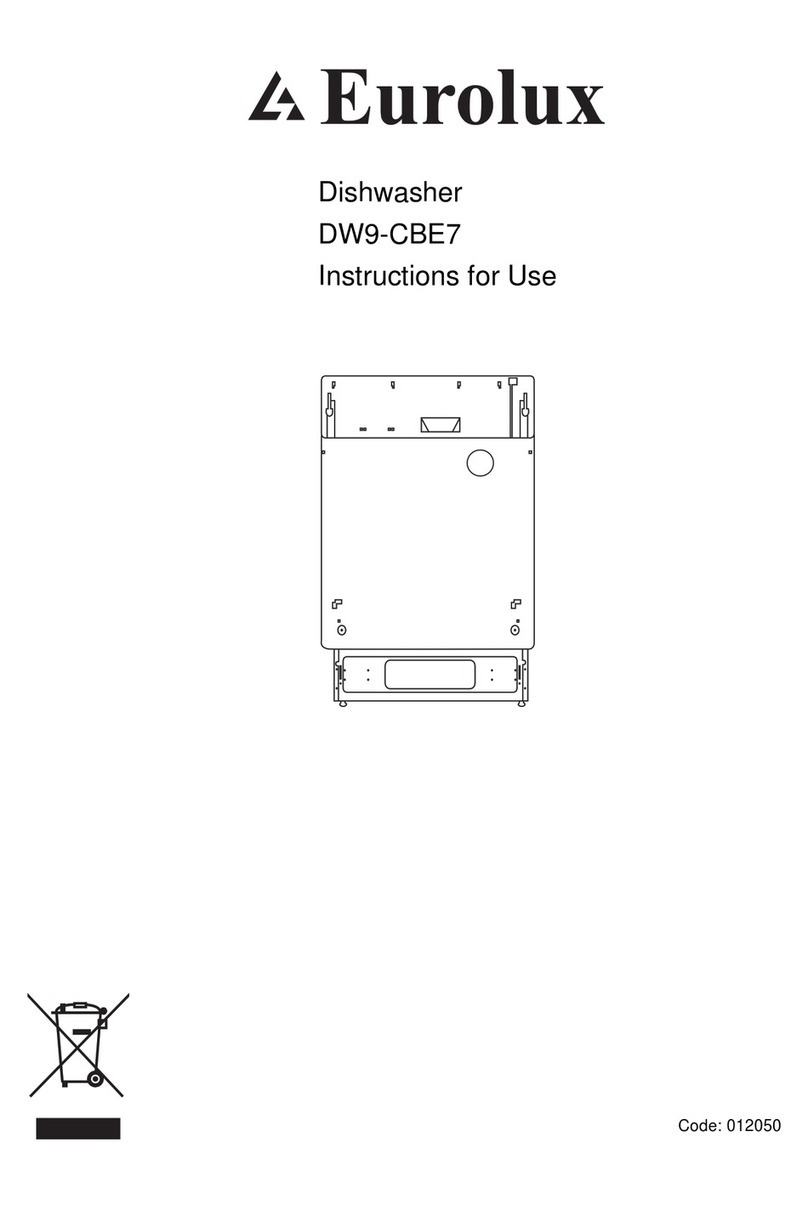
Eurolux
Eurolux DW9-CBE7 User manual
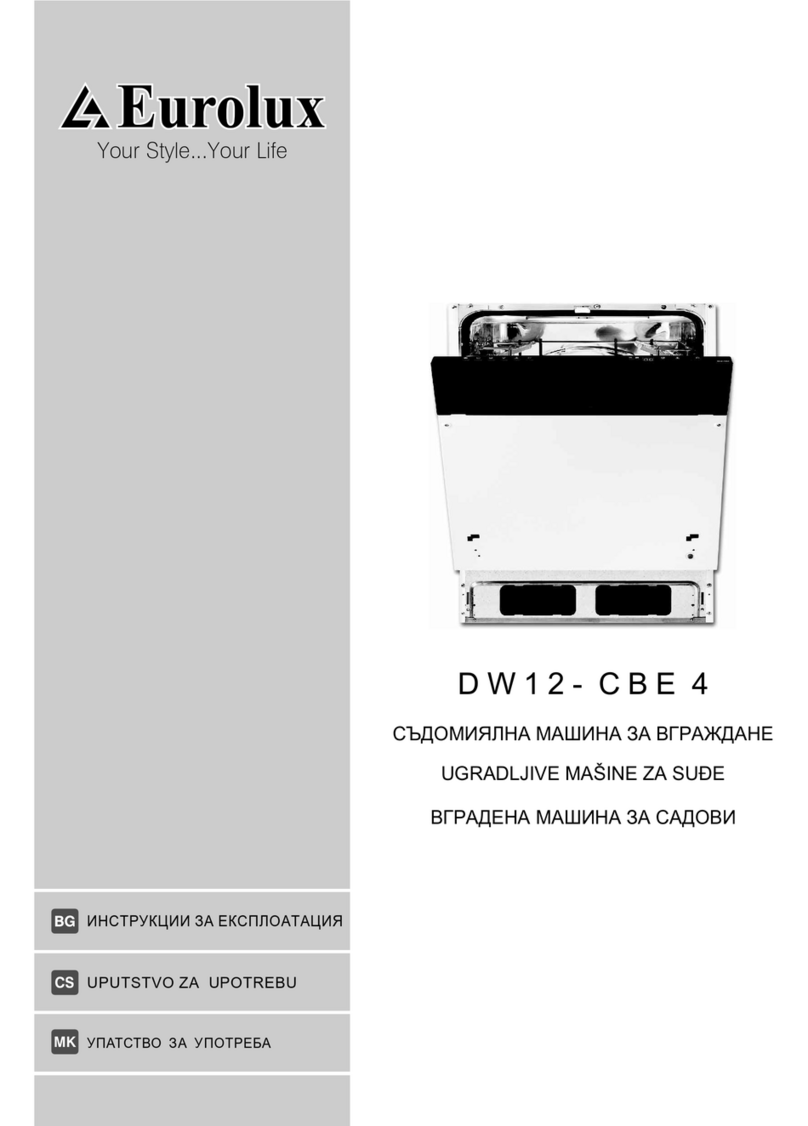
Eurolux
Eurolux DW12-CBE4

Eurolux
Eurolux DW9-CBE Troubleshooting guide
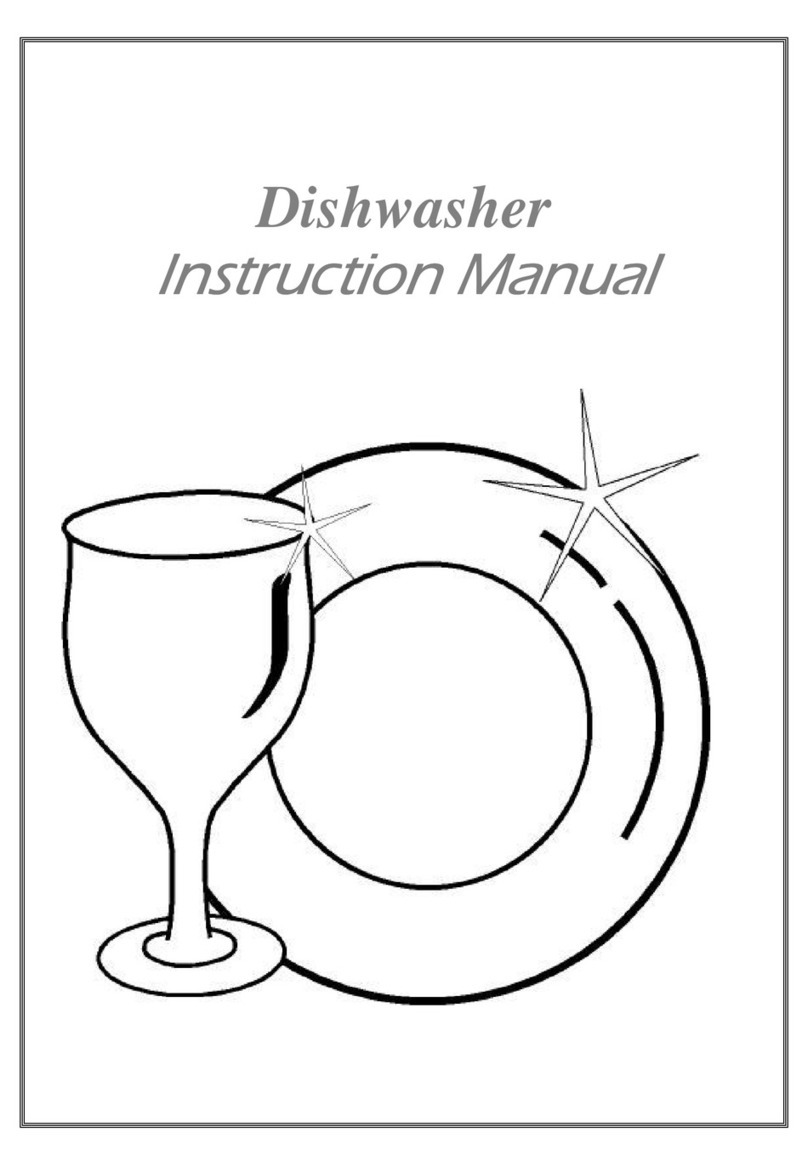
Eurolux
Eurolux DW10V--AAA--6 User manual
